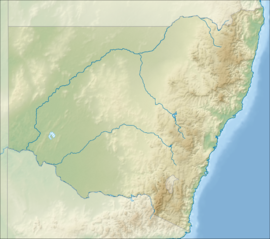Boginderra Hills Nature Reserve
|
Boginderra Hills Nature Reserve New South Wales |
|
|---|---|
|
IUCN category Ia (strict nature reserve)
|
|
| Nearest town or city | Temora |
| Coordinates | 34°16′28″S 147°37′45″E / 34.27444°S 147.62917°ECoordinates: 34°16′28″S 147°37′45″E / 34.27444°S 147.62917°E |
| Established | 1982 |
| Area | 7.56 km2 (2.9 sq mi) |
| Managing authorities | NSW National Parks & Wildlife Service |
| Website | Boginderra Hills Nature Reserve |
| See also | Protected areas of New South Wales |
Boginderra Hills Nature Reserve is a protected nature reserve situated to the north of Temora, located in the Riverina region of New South Wales in eastern Australia. It has an area of 756 hectares.
The reserve was formed in 1982 when NSW Parks and Wildlife purchased 551 hectares of mainly forested granite hill, recognising the conservation value of the area. In August 2005, an additional 205 hectares of adjacent and similar hill country were purchased and added to the reserve.
The reserve covers the Boginderra Hills, which form the main ridge of the Nurraburra Hills. Its highest point rises to 494 metres above sea level. These hills are made of Boginderra Granite, which was formed from cooling magma bodies from deep within the earth. These bodies, known as plutons, then lifted through the crust to their current positions. This occurred around 370 million years ago (in the Late Devonian period). The granites in the Nurraburra Hills are around 77% silicon dioxide (Si02) and 11% aluminum oxide (Al2O3), with a range of other metal oxides present. No mining surveys have been conducted, however drilling has been completed in other hills in the Nurraburra complex which has shown the presence of some rare earth elements, however none in any economic quantity.
Plant life is typical of the area, including eucalypt, callitris and acacia species (amongst others) covering a range of native shrubs, grasses and ground covers. Key populations present in the reserve include:
Kurrajong trees (Brachychiton populneus) are interspersed across the reserve
There are two plant species of conservation significance in the reserve, Brunonia australis, a small blue-flowering annual, and Mitrasacme paradoxa, a small perennial herb.
...
Wikipedia

